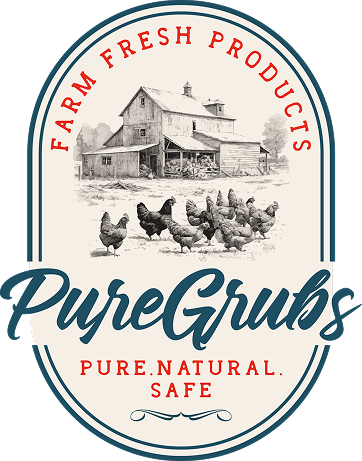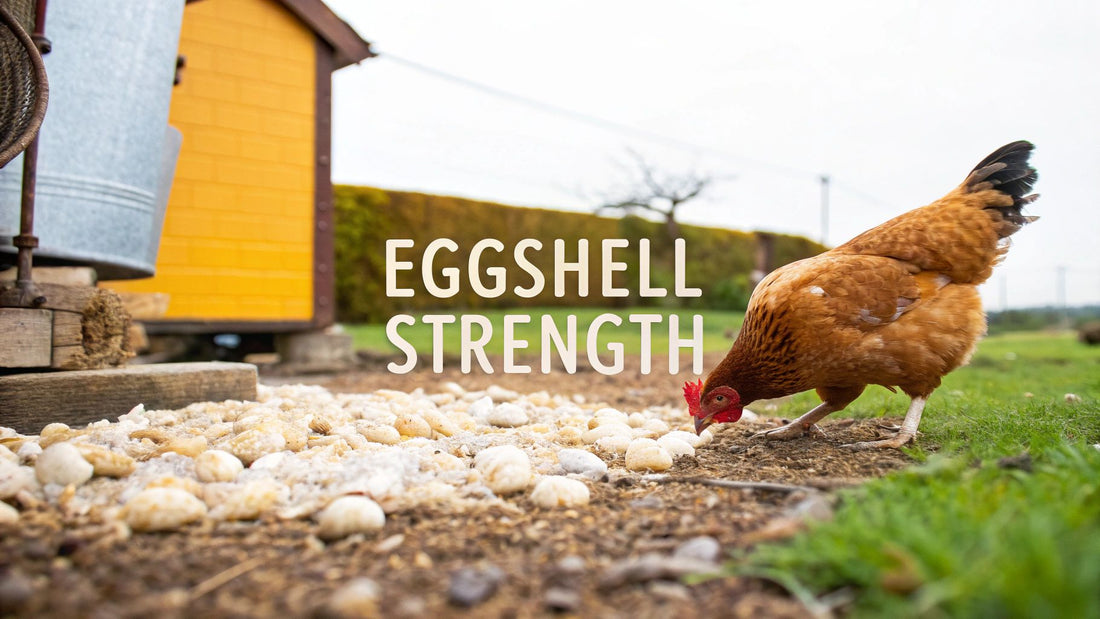
Best Calcium Supplement for Chickens Ultimate Guide
Share
When it comes to the best calcium supplement for chickens, free-choice crushed oyster shell is the hands-down winner. Its slow-release nature is perfectly timed to support eggshell formation, which happens mostly overnight. For a laying hen, this steady, reliable supply is what she needs to build strong, healthy eggs without raiding her own bone reserves.
Why Your Chickens Need a Calcium Supplement
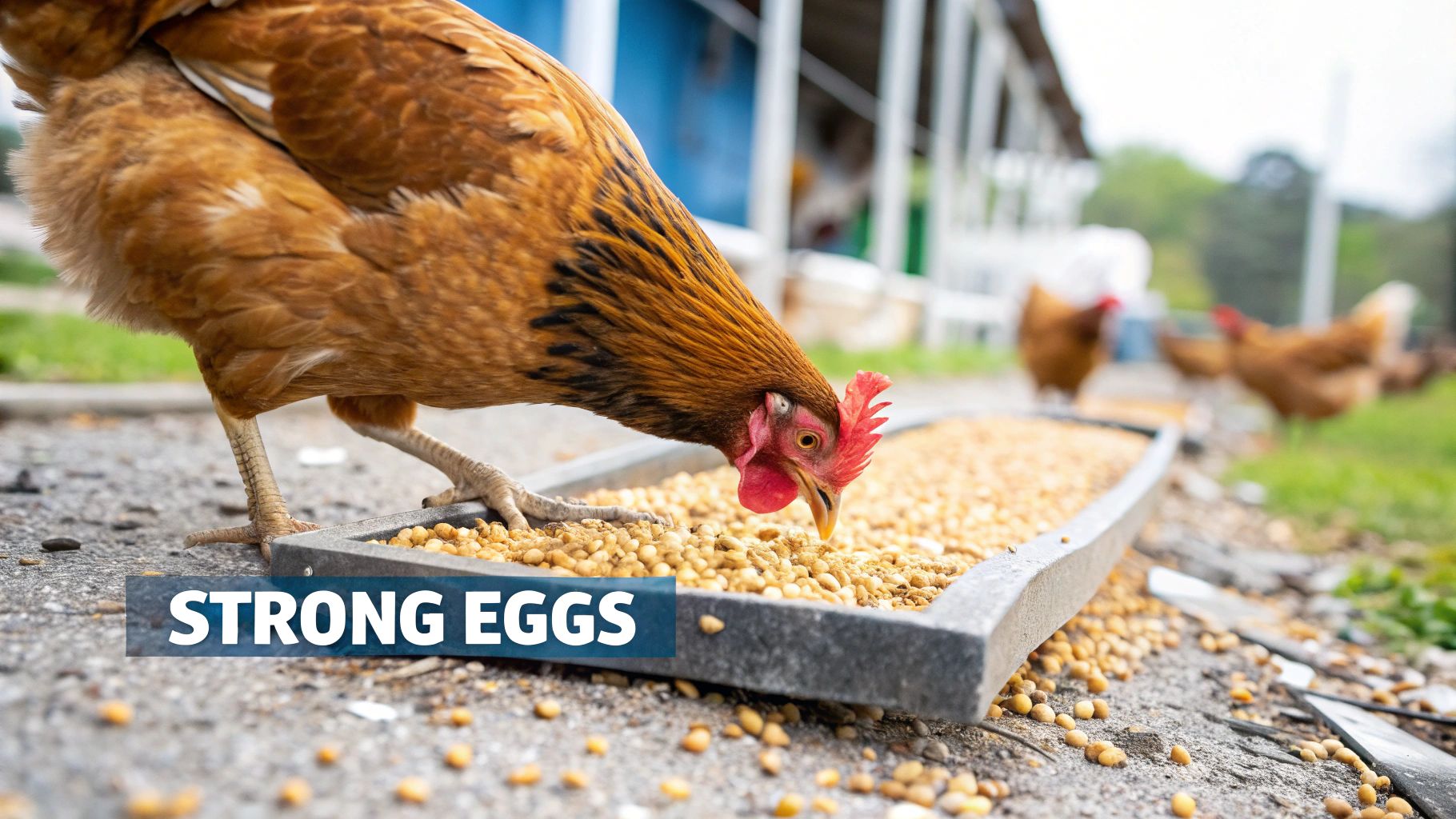
Think of a laying hen as a tiny, feathered factory. Every single eggshell she produces is made of about 95% calcium carbonate. That means she needs to find roughly 2 grams of calcium in her diet each day just to form one egg.
If her feed doesn't provide enough, her body has a backup plan: it pulls calcium directly from her bones. This biological failsafe keeps egg production going for a while, but it's a dangerous loan against her long-term health.
The Consequences of Low Calcium
A consistent calcium shortfall triggers a chain reaction of problems, and the first signs usually show up in the nesting box.
- Thin or Soft Shells: You might notice eggs that feel flimsy, rubbery, or crack the moment you pick them up.
- Shell-less Eggs: In more serious cases, you'll find an egg that's only enclosed by its soft inner membrane.
- Reduced Production: Eventually, a hen's body will hit the brakes and slow or stop laying altogether to protect its own calcium supply.
It’s not just about egg quality, either. A long-term deficiency can lead to some truly serious health problems. Osteoporosis can leave a hen vulnerable to broken bones, and a life-threatening condition called egg binding—where an egg gets stuck—can become a real risk.
Why Standard Feed Is Not Always Enough
Even a top-tier layer feed might not be enough for every bird, especially for prolific breeds that are laying almost daily. There's another complication, too. If you have a mixed flock with roosters or non-laying hens, a feed high in calcium can actually harm them by causing kidney damage.
This is precisely why offering a separate, free-choice calcium source is the industry gold standard. It empowers each hen to take exactly what she needs, right when she needs it, based on her individual laying cycle. This simple step ensures your layers are supported without putting the rest of the flock at risk. Understanding these nuances is key to good flock management, and you can learn more about our philosophy on poultry nutrition by exploring the Pure Grubs story.
Comparing the Top Chicken Calcium Supplements
When it comes to picking a calcium supplement for your flock, it’s not as simple as grabbing the cheapest bag off the shelf. Every source—whether it’s crushed oyster shell, ground limestone, or even your own recycled eggshells—brings something different to the table. Each one has a unique profile that directly impacts how your hens absorb and use this crucial mineral for strong eggshells.
Let's dig into the details of these top contenders. We'll look at their calcium content, the size of the particles, how quickly they're absorbed, and the overall cost. The goal isn't to crown one "winner," but to give you the know-how to pick the perfect fit for your flock's needs.
The infographic below shows the three most common calcium sources you'll find for backyard chickens.
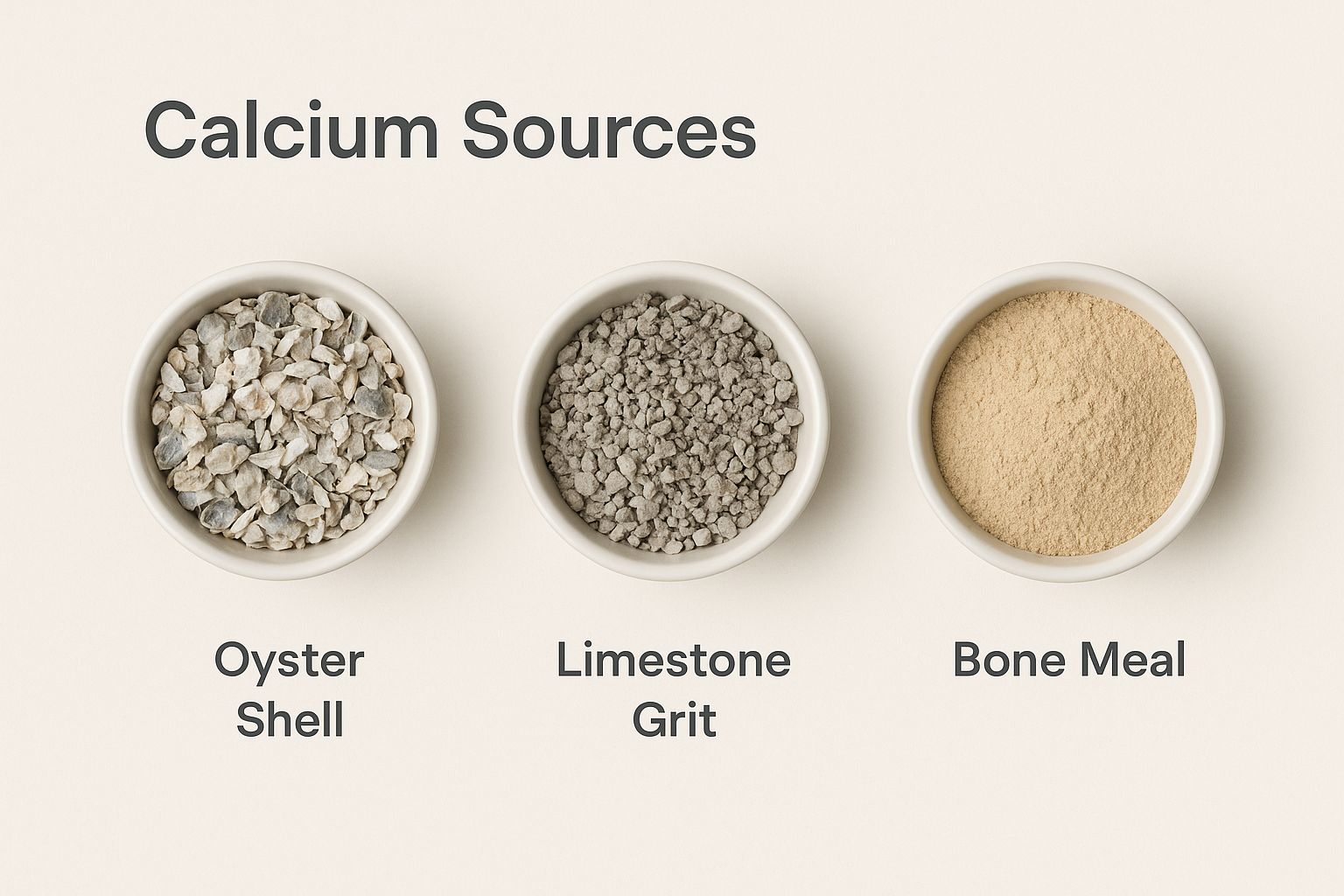
As you can see, the different textures play a huge role in how the calcium is digested and used by the hen.
Crushed Oyster Shell: The Slow-Release Champion
There's a reason crushed oyster shell is often seen as the gold standard for laying hens. It all comes down to its particle size and composition. The shell fragments are large and irregular, which means they don't get digested all at once.
Instead, they sit in the gizzard for hours, slowly metering out calcium into the bloodstream. This is a game-changer because eggshell formation kicks into high gear overnight while your hens are roosting. Oyster shell ensures a steady supply of calcium is available right when they need it most.
Why It Works: The biggest win for oyster shell is its slow-release timing. This sustained delivery of calcium perfectly supports the 20-hour process of eggshell calcification, leading to noticeably stronger, thicker shells.
Ground Limestone: The Quick and Affordable Boost
Ground limestone, which you might see sold as poultry grit, is another fantastic source of calcium carbonate. The key difference between it and oyster shell is its particle size and how fast it gets absorbed. Limestone is typically ground into smaller, more uniform pieces.
Because it's finer, it dissolves more quickly in a hen's digestive system, giving her a more immediate calcium hit. While it doesn't offer that same all-night release like oyster shell, it's a super effective and often more budget-friendly choice for daily supplementation. With a high calcium content of around 38% and a lower price tag, it's a practical go-to for many flock raisers.
Recycled Eggshells: The Sustainable DIY Option
Putting your flock's own eggshells back to use is a brilliant way to recycle nutrients and cut down on waste. To do it safely, you must wash the shells, bake them to destroy any pathogens like salmonella, and crush them into tiny, unrecognizable pieces. That last step is non-negotiable—if they look like eggs, you might accidentally encourage egg-eating.
While recycled eggshells are a great free resource, relying on them alone can be a gamble. It's tough to know for sure if you're providing enough calcium to keep up with a productive flock. It's best to use them as a "bonus" supplement alongside a more consistent source like oyster shell or limestone, not as the main event.
Head-to-Head Chicken Calcium Supplement Comparison
Here’s a direct analysis of oyster shell, limestone, and crushed eggshells based on the key nutritional and practical factors that matter for your flock's health.
| Supplement Type | Calcium Content (%) | Particle Size | Absorption Rate | Best For | Cost |
|---|---|---|---|---|---|
| Oyster Shell | ~38% | Large, Flaky | Slow, Sustained | Overnight eggshell formation, high-production layers. | $$ |
| Ground Limestone | ~38-40% | Fine to Medium | Fast, Immediate | Budget-conscious flock owners needing a quick boost. | $ |
| Crushed Eggshells | ~39% | Variable (DIY) | Moderate to Fast | Supplemental use, reducing waste, small flocks. | Free |
This table makes it clear that each option has a specific job it does best. There’s no single right answer, just the right answer for your flock and your management style.
Ultimately, keeping your flock healthy and productive is the main goal. While calcium is a cornerstone, a well-rounded diet needs protein and other key nutrients, too. You can explore high-quality treats like dried grubs in our full range of products to perfectly complement their daily feed.
Oyster Shell: The Gold Standard for Laying Hens
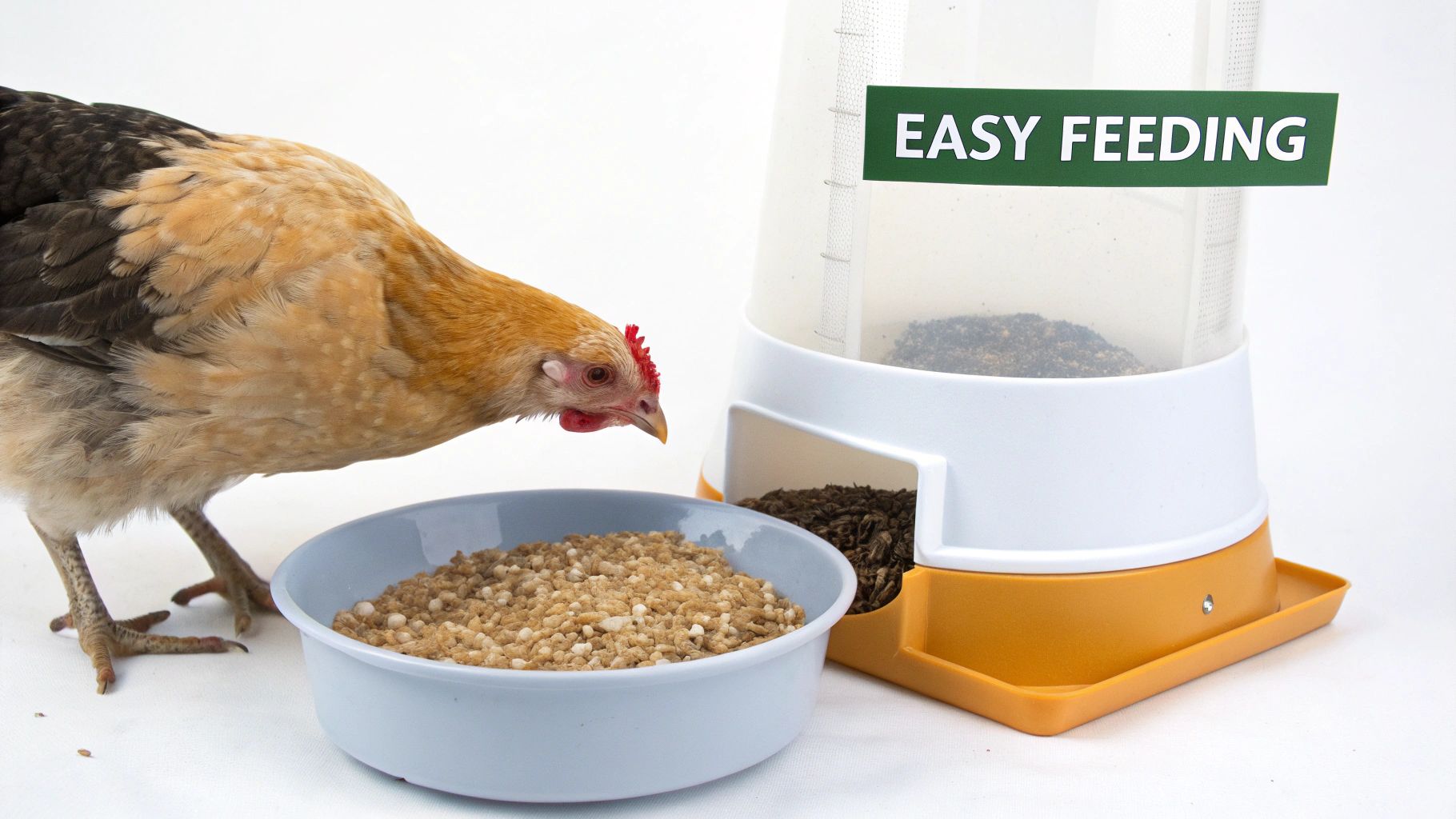
When you ask seasoned chicken keepers what they use for calcium, one answer comes up more than any other: crushed oyster shell. It has absolutely earned its reputation as the gold standard, and the reason goes far beyond just being a source of calcium. Its real magic lies in its physical form.
The secret is the coarse, flaky texture. Unlike powdery supplements like ground limestone that get digested quickly, these larger oyster shell fragments hang out in the hen's gizzard for a while. This means the calcium is released slowly and steadily into her bloodstream over many hours.
This slow-drip delivery system is perfectly timed with a hen's natural egg-laying cycle. The most demanding part of shell formation happens overnight while she’s on the roost. Having that steady supply of calcium available right when she needs it most prevents her body from having to pull it from her own bones, which is exactly what we want to avoid.
The Science of Stronger Shells
This isn't just backyard chicken wisdom; it's a proven strategy that commercial poultry operations rely on to maintain egg quality. By making sure calcium is available all night long, they see a real, measurable drop in the number of thin, cracked, or weak-shelled eggs. For high-production breeds that are laying an egg almost every day, this is non-negotiable.
The Key Differentiator: Oyster shell acts as a natural, time-release calcium source. This unique ability to support a hen's overnight needs directly results in stronger eggshells and better long-term skeletal health for the bird.
With an elemental calcium content of around 38%, oyster shell is also incredibly efficient. It’s a cornerstone of poultry nutrition for a reason. The global market for poultry feed supplements, valued at around $4.5 billion in 2022, is built on proven, effective ingredients like oyster shell. You can learn more about the scale of this industry by exploring the latest industry data.
When to Invest in Oyster Shell
Yes, oyster shell often costs a bit more than a bag of ag-lime, but the payoff is significant, especially in a few key situations.
- For Prolific Layers: If you have a flock of egg-laying machines like Leghorns or Golden Comets, providing free-choice oyster shell is one of the best things you can do to prevent shell problems before they start.
- For Older Hens: As hens get older, their bodies become less efficient at absorbing and using calcium. The constant availability from oyster shell gives them the support they need to keep laying strong.
- For Improving Shell Quality: Are you already seeing flimsy or weak shells? Making the switch to oyster shell is the most effective first step you can take to turn things around.
What About Limestone and Crushed Eggshells?
While oyster shell often gets all the credit, it’s far from the only game in town for keeping your laying hens healthy. A couple of really practical, budget-friendly alternatives—agricultural limestone and even your flock's own eggshells—can do a fantastic job. Knowing the pros and cons of each will help you figure out what makes the most sense for your birds and your wallet.
Limestone is a powerhouse source of calcium carbonate, and honestly, it's what many commercial operations rely on. Its biggest selling point? It's usually much cheaper than oyster shell, which makes it a smart choice if you're managing a large flock and trying to keep feed costs down.
You'll typically find it sold as poultry grit, and you'll notice it's made of finer, more consistently sized particles compared to the chunkier oyster shell. This smaller size means it breaks down faster in a hen's digestive tract, giving her a quick hit of calcium. While that’s great for meeting daily needs, it doesn't provide the same slow, overnight release that makes oyster shell so effective for strong eggshell formation.
Using Recycled Eggshells the Right Way
Putting your flock's eggshells back into their diet is a brilliant, zero-waste way to close the nutrient loop. But, and this is a big but, you have to do it correctly. If you cut corners, you could introduce bacteria into your flock or, worse, teach your hens the terrible habit of eating their own eggs.
Here’s the safe and effective method I've used for years:
- Clean Them Out: First, rinse the shells thoroughly. You don't want any egg white or yolk residue left behind.
- Dry and Sterilize: Spread the clean shells on a baking sheet and pop them in the oven at a low temp, around 200°F (93°C), for about 10 minutes. This step is non-negotiable—it dries them out completely and kills off nasty pathogens like salmonella.
- Crush 'Em Up: Once they're cool, grind the shells into tiny, unrecognizable pieces. A blender, food processor, or even a rolling pin and a sturdy bag will work. The goal is a coarse powder, not something that still looks like an eggshell.
Critical Safety Tip: Never, ever feed your hens large, recognizable pieces of eggshell. They must not make the connection between this supplement and the eggs they lay. Once they learn that eggs are food, you've got a very difficult habit to break.
So, When Should You Use Them?
Both limestone and recycled eggshells have their place. If you're looking for a primary calcium source and budget is a top priority, limestone is an excellent, reliable choice that provides all the essential calcium your flock needs.
Recycled eggshells, on the other hand, are best thought of as a free bonus supplement, not the main source for your high-producing hens. They're a fantastic way to add a little extra calcium to the diet without spending a dime. But because it's hard to guarantee you'll have a consistent and sufficient supply, it's risky to rely on them alone. A perfect strategy is to offer them alongside a primary source like limestone or oyster shell.
How to Choose the Right Supplement for Your Flock
Figuring out the best calcium supplement for your chickens isn’t about a one-size-fits-all solution. It's about matching the supplement to your specific situation. A flock of high-production Leghorns laying an egg a day has vastly different needs than a mixed backyard group of hens, roosters, and retired birds. Your decision really comes down to your flock's unique makeup, their ages, and what you’re feeding them.
The single most important rule? Never mix calcium directly into their main feed. You should always offer it free-choice in a completely separate container. This one simple step is the key to managing calcium correctly and keeping everyone healthy.
Tailoring to Your Flock Composition
If you have a mixed flock with roosters and non-laying hens, you should never force them onto a high-calcium layer feed. Roosters and young pullets simply don't need all that extra calcium, and giving it to them can cause serious, long-term kidney damage.
By putting out a separate container of oyster shell or limestone, each bird can decide for itself what it needs.
- Laying Hens: Will instinctively visit the calcium station, often in the afternoon or evening when their bodies are gearing up for shell formation.
- Roosters and Non-Laying Birds: Will simply ignore the supplement because their bodies aren't telling them they need it.
This self-serve approach ensures your hard-working layers get the 4-5 grams of calcium they need daily without putting the rest of the flock at risk.
The free-choice method empowers each bird to manage its own intake. This prevents the dangerous over-supplementation of non-layers while ensuring prolific hens have exactly what they need to form strong, healthy eggshells.
Age, Breed, and Diet Considerations
A hen's ability to absorb and use calcium changes as she gets older, and a breed's laying intensity drives its demand. An older hen, for instance, might need a more readily available source to keep producing strong eggs, which is where a slow-release option like oyster shell really shines. The poultry feed supplement market, valued at a whopping $14.5 billion in 2024, is built around this need for targeted nutrition. You can explore more about global poultry supplement trends on marketresearch.com.
It’s no surprise that oyster shell and limestone dominate this market; they are the proven, go-to choices for everyone from commercial farms to backyard chicken keepers.
What your flock eats beyond their commercial feed matters, too. If you're generous with kitchen scraps and treats, you're diluting the balanced nutrition in their main feed. This makes offering supplemental calcium even more critical to fill in the gaps. A high-protein diet is just as important, and the right treats can help with that. You can read our guide on the benefits of dried grubs for chickens to learn more.
When you put all these pieces together—flock composition, age, and overall diet—you can confidently choose the perfect calcium strategy for your birds.
Common Questions About Calcium for Chickens
Even the most seasoned chicken keeper runs into questions now and then. When it comes to calcium, getting the details right is crucial for your flock's health and the quality of their eggs. Let's tackle some of the most frequent questions I hear from fellow flock owners.
Getting these answers straight will help you feel more confident in how you care for your birds.
How Much Extra Calcium Do My Hens Actually Need?
A laying hen requires a surprising amount of calcium—about 4-5 grams every single day. That's what it takes to form a strong eggshell without pulling critical calcium from her own bones. While a high-quality layer feed is the right start, it's rarely the whole story.
The best approach, hands down, is to offer a supplement like crushed oyster shell or limestone free-choice. Just put it in a separate dish from their regular food. This lets each hen take exactly what her body tells her she needs, which can change day-to-day. A good rule of thumb is to start with one or two tablespoons per hen each week and see how fast they go through it, then adjust from there.
Can I Just Feed Their Own Eggshells Back to Them?
Yes, you can, and it's a great way to recycle nutrients! But you have to do it right. The shells must be washed, baked at a low temperature until they're completely dry and brittle, and then crushed into tiny pieces. They shouldn't look like eggshells anymore.
A Quick Warning: Skipping the baking step risks spreading diseases like salmonella. More importantly, feeding them recognizable shell pieces can teach your hens to start eating their own fresh eggs—a habit that's incredibly difficult to break. While a great supplement, recycled shells alone might not be enough for a flock of hard-working layers.
When Is the Right Time to Start Offering Calcium?
You'll want to introduce a separate calcium source when your young hens (pullets) are around 18-20 weeks old. This is typically just before they lay their first egg.
Giving it to them any earlier can be hard on their kidneys, which aren't yet developed to handle that much calcium. But if you wait until after they've started laying, you'll likely see weak or soft-shelled eggs right from the start. By offering it free-choice, you empower them to start taking it only when their bodies signal that it's time.
Is It Possible for a Chicken to Get Too Much Calcium?
Absolutely. Too much of a good thing can cause real problems. If a chicken ingests excess calcium, it can lead to a condition called hypercalcemia, which can damage the kidneys and cause visceral gout. It also messes with their ability to absorb other important minerals.
This is exactly why offering calcium "free-choice" is so important. It prevents your roosters, non-laying hens, and young birds—who all have much lower calcium needs—from accidentally consuming levels that could be harmful to them.
A great diet is more than just calcium. For strong shells and vibrant birds, high-quality protein is just as important. Pure Grubs offers premium, USA-grown Black Soldier Fly Larvae with up to 85% more calcium than mealworms, giving your flock a natural, healthy boost. Check out our products at https://puregrubs.com.
Article created using Outrank
